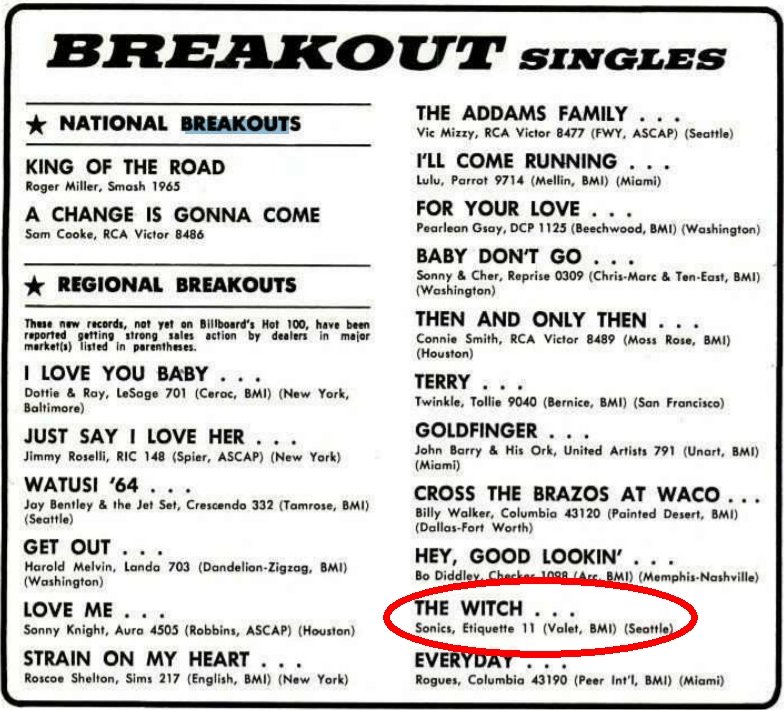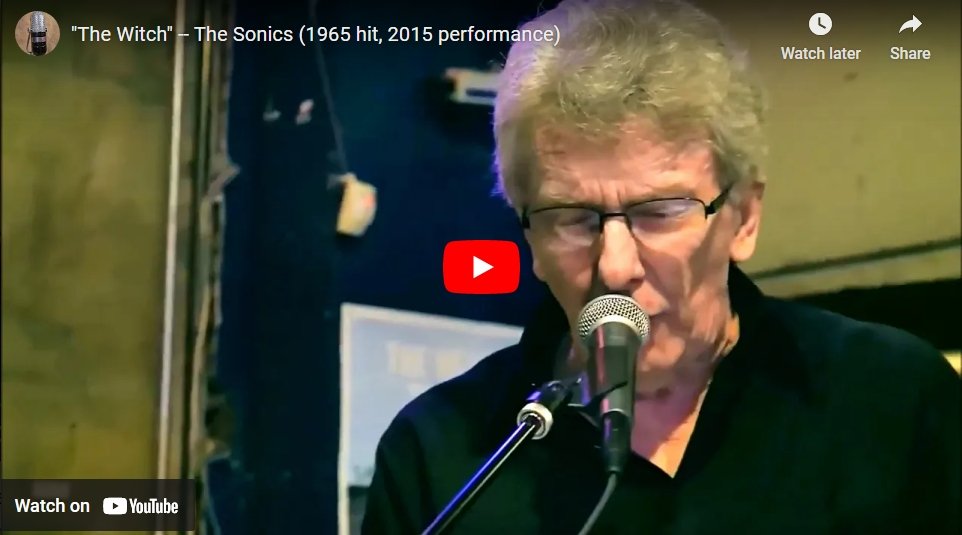
In 2020, Kirk Wilde drawing on his memory and historical sources traced the roots of homegrown Pacific Northwest rock music (Click HERE to read the article). He described several artists who were important to the development of the northwest sound. That got me wondering if there were performance videos of those northwest artists that Wilde had written about.
The pickings are slim. Most of the northwest artists had regional fame, but not so much nationally. They did not appear on television or in film. Exceptions that come to mind include The Fleetwoods, Paul Revere & The Raiders, The Ventures, The Kingsmen, Merrilee Rush, Don & The Goodtimes and vocalist Kathi McDonald. A number of video performances by these artists are still available today.

The Sonics, from Tacoma, WA, are rated as the godfathers of garage rock. Music historians often credit them for the emergence of the punk and grunge sound. That said, for many years they were mainly a Pacific Northwest phenomenon. After a few mid-’60s regional hits that were played on KJR, KOL and the northwest rockers, the Sonics faded into the background for several years. Later the band began touring again. And they kept touring for many years. In Europe the Sonics are hailed as rock icons.
Nationally, in Billboard magazine, the best they did was credit for a Regional Breakout Single on Jan. 30, 1965 for “The Witch.” (And a repeat of that for “You Got Your Head on Backwards” on Sept. 3, 1966.)

Moving ahead 50 years, in April 2015, the Sonics took a break from touring and made a rare appearance in Seattle. The show, live at Easy Street Records, was recorded and the soundtrack is available for purchase. The audio and video were mixed and edited by KEXP -FM in Seattle.
 From that Easy Street Records show, I have selected “The Witch.” It was early on in The S0nics’ evolution and the song was hard-driving, raw and intense. If you were a kid in the northwest in the sixties, you heard “The Witch.” I am told that any band that played around here back then had to cover “The Witch.”
From that Easy Street Records show, I have selected “The Witch.” It was early on in The S0nics’ evolution and the song was hard-driving, raw and intense. If you were a kid in the northwest in the sixties, you heard “The Witch.” I am told that any band that played around here back then had to cover “The Witch.”
Even all these years after “The Witch” was originally released, the Sonics were still rocking in 2015. Gerry Roslie, lead vocalist, was back belting out the lyrics in good form (after having had a heart transplant in 2008). Past and present band members, who appeared in various sets at Easy Street, included Sonics’ founder, Andy Parypa (bass), and his brother Larry Parypa (lead guitar), Rob Lind (sax), Freddie Dennis (bass & vocals), Dusty Watson (drums), and Gerry Rosalie (vocals and keyboard).
On “The Witch,” regular drummer Dusty Watson was replaced by Mark Pickerel of Screaming Trees and Soundgarden’s Ben Shepherd played bass. Technical notes: Original feedback in the soundtrack has been mostly eliminated and lip sync adjusted.
Another QZVX article featuring the Sonics and highlighting their hit “Psycho” is available by clicking HERE.

March 20, 2021 at QZVX
Steven Smith says:
Gordon….it looks like the album was released on vinyl and not CD. However KEXP has the video of the show free online. It would not be difficult to dub the audio. If you need anything else you can email me at
ssmith@qzvx.com
Here is the link to the show.
https://www.kexp.org/read/2016/4/14/live-video-the-sonics-live-at-easy-street-records/
March 19, 2021 at QZVX
Gordon K Iverson says:
Steve, is there any way I could acquire 1-3 copies of the Sonics soundtrack that was recorded and filmed at KEXP?
March 18, 2021 at QZVX
Brian Lord says:
When KTW switched from beautiful music after the sale in 1964 I was 18. Now I am 75 and I have lost some of the bits and pieces in my memory. I think they fall out every time I blow my nose.
March 18, 2021 at QZVX
Brian Lord says:
I was 18 when KTW switched from beautiful music/religion to top 40 and now I am 75. I still can remember my name. But it wasn’t Tom, Dick, Harry or Sam. (wink)
March 18, 2021 at QZVX
Steven Smith says:
Thanks for thinking about it Brian. Lots of memories in our brains at this age. I still remember the first time I ever saw a live brontosaurus.
March 18, 2021 at QZVX
Brian Lord says:
I was there when KTW switched from easy listening to top 40 in 1964. I was 18 and am now 75. I think I lose a bit of my memory every time I blow my nose.
March 18, 2021 at QZVX
Brian Lord says:
My memory has been jogged. The engineer for KTW AM-FM was an older gentleman named Jim Ross. He worked for Seattle City Light as well as helping out at KTW. I believe he must have been a member of the First Presbyterian Church.
March 17, 2021 at QZVX
Steven Smith says:
Jay…I was not implying the engineer received any royalties. I would expect an hourly or by session paycheck. I was implying, per Brian’s remarks, that there probably was not much money in being a PNW sound enginer even though many of the songs are now highly regarded collector’s items. I also was not surprised the engineer would moonlight in a related field like parttime jock as a way to supplement his income.
March 17, 2021 at QZVX
Jay Hamilton says:
Oh, I guess I did misunderstand. I just figured that Kearney Barton must have made a pretty damn good living without a need for moonlighting. My understanding is he started out with a radio show on KTW-Seattle in the early 50s and then to KNBX-Seattle in 1958 as an engineer. By 1961 he opened his own recording studio (Audio Recording, Inc.) and then move it to a larger space by 1965. He spent decades recording the cream of the crop of Seattle recording artists. The Fleetwoods, Quincy Jones, The Wailers, The Frantics, Little Bill & The Bluenotes, The Kingsmen, Dave Lewis and so many other acts who only had minor success. It was basically his studio and I’m fairly sure he wasn’t giving away studio time! Most studios charged by the hour with a fluctuating scale depending on the time of day. Ad Agencies also used his studios for recording commercials, etc. My guess would be he made a pretty good living. But, when you get right down to it, it’s only a guess!
March 18, 2021 at QZVX
Jack D. Bell says:
When I interviewed Kearney, he was situated in his final studio–which was the basement of his home over in the area of the University village in Seattle…wow, it was pretty disorganized!…lots of tapes and recording related gear all over the place…and Mr. Barton suggested that he had recorded the teenage Jimi Hendrix, when he was with one of his local groups…I was not about to contradict the man, but I knew he was mistaken…the only group that he played with that entered a studio, was his last group, called Tom and the Tomcats–they were likely the ones Kearney recorded–but Hendrix had already entered the Army (31May 1961) and therefor were without Jimi when they recorded a 45 during the summer of 1961. Mr. Barton was sure he had the tape–somewhere–but admitted that his archives were all scattered. Also, he was a little shaky with his memory–I could not get him to remember, that he had recorded a 45 featuring an aunt of mine, back in the mid-70s (it went nowhere!).
March 18, 2021 at QZVX
Steven Smith says:
Jay…I had never heard of him until a year or so back you told me about him being at the Kathi McDonald and The Unusuals session. I will have to look him up again.
March 17, 2021 at QZVX
Steven Smith says:
Brian….I imagine that back in those days moonlighting in similar fields made sense. There could not have been all that much money in being the recording engineer on PNW releases…although many of them became much more important to historians than might have been anticipated at the time.
March 17, 2021 at QZVX
Jay Hamilton says:
I’ve never known of any recording studio engineer making any kind of royalty payment from record sales. They, under normal circumstances, would receive their money up front for the recording session …. from the record company or A&R producer. In reality, they are the only person (beyond the studio owner) making money off of every record … regardless of sales.
March 17, 2021 at QZVX
Brian Lord says:
Steven, when I saw your reply, it jogged my now foggy memory. I have to retract that statement I made. Kearney worked on the weekends as a fill in dj occasionally and he engineered the Sunday broadcast that was at the First Presbyterian Church and carried on KTW. I started thinking and now I believe the engineer was a older gentleman with the first name Jim and his regular job had nothing to do with radio stations. Maybe Dave Hebert can remember the engineers last name.
March 16, 2021 at QZVX
Steven Smith says:
Brian….that is interesting because in my experience most recording engineers were sound guys with a discriminating ear…not RF and antenna guys.
March 16, 2021 at QZVX
Brian Lord says:
Kearney Barton also did engineering work for KTW. He installed the transmitter for KTW-FM. I was in the studio on Madison St. and he was at the transmitter at Pigeon Point in West Seattle when we got it on the air for the first time.
March 16, 2021 at QZVX
Jay Hamilton says:
Kearney Barton was also the studio engineer on The Unusuals’ “I’m Walkin’ Babe”. I always suspected Harvey Redmond (the band’s lead vocalist on that tune) was channeling Gerry Rosalie’s trademark scream with his choice of delivery on the word “Yeah” in “Walkin’ Babe”. The resulting sound isn’t similar, but the energy is.
March 16, 2021 at QZVX
Steven Smith says:
Interesting story…thanks for that Jack. Makes sense. Those records were pretty distorted.
March 16, 2021 at QZVX
Jack D. Bell says:
Many years ago, I interviewed Kearney Barton, the studio wizard who recorded a couple of the hits by the Sonics…he admitted to me, that he never really could explain just why the group sounded so uniquely nasty and intense on their recordings…I suggested that they simply played so extremely loud, that the equipment of his studio was overdriven, distorted in a way that soon began to be a “sound” that other groups wanted to explore. He simply said–“That must be it…there is no other explanation that makes sense!”
March 16, 2021 at QZVX
Kirk Wilde says:
No, Jack, it wasn’t just about volume. They had real R&R chord progression songs sung by a true believer, backed with astonishing hard sax & percussion arrangements, yet still elemental. Liberating everything stuck in your soul.
Now go to the studio version, and “Shot Down”, “Psycho” and “Cinderella”. Their “Louie” gets it too.
March 17, 2021 at QZVX
Jack D. Bell says:
I definitely can agree with your words–“elemental”, “astonishing hard sax and percussion”–and on top of all that, was Jerry Roslie, sounding even more powerful than Little Richard !…but that distortion sound was something new, and was sought after by many a “garage band” as the 60’s rolled on.